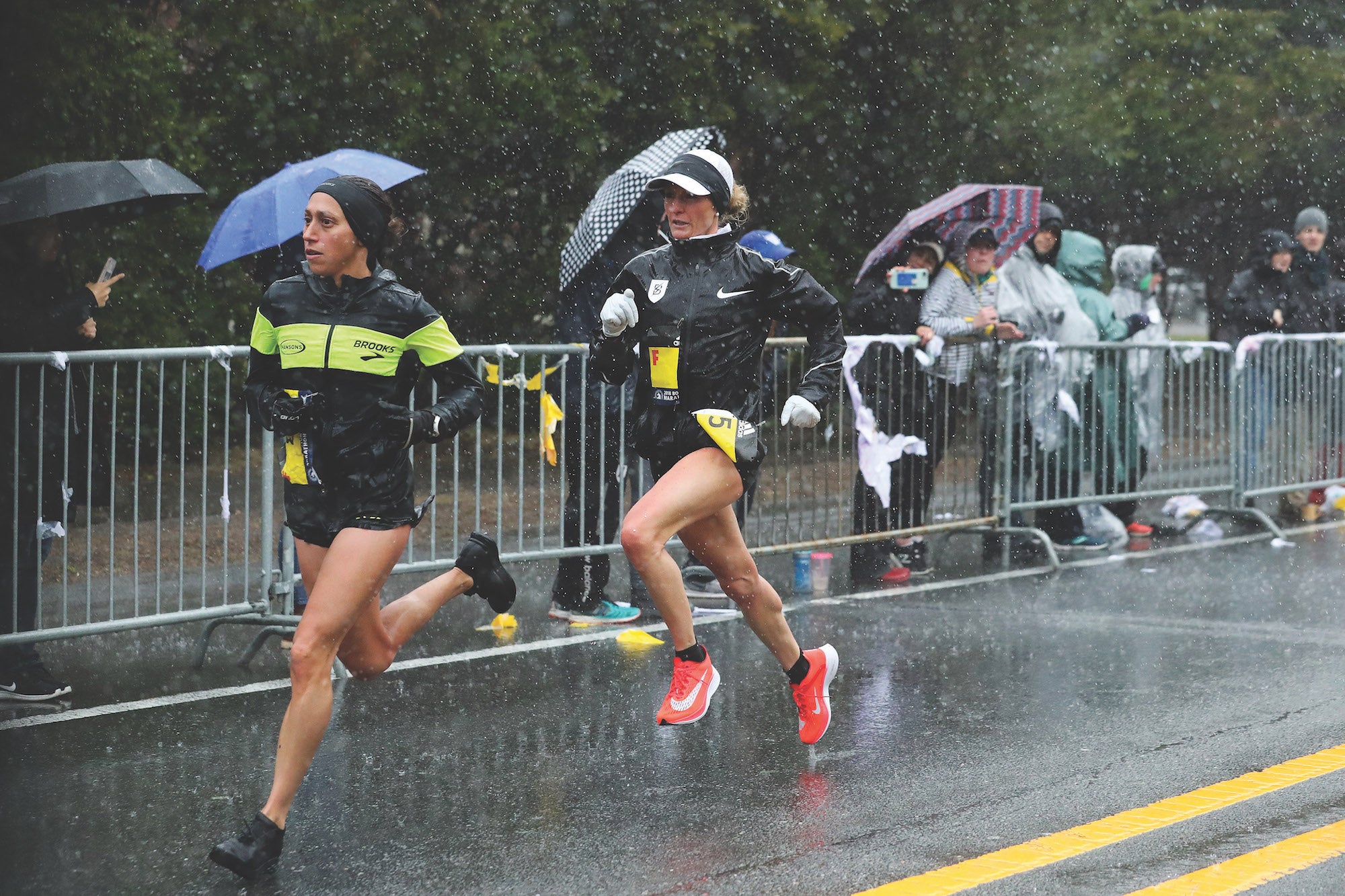What Runners Should Celebrate on International Women’s Day

Photo of Des Linden and Shalane Flanagan during the 2018 Boston Marathon by PhotoRun.
In many ways, running is a place where men and woman today experience more equality than many other sports and professions. But of course it wasn’t (and still isn’t) always the case. Lest we forget, just a couple generations ago, men told us our uteruses would fall out if we ran more than 800 meters at a time.
Now, with our reproductive organs still intact, we’re training through pregnancies, earning equal prize money, competing in (mostly) the same events and distances, and even breastfeeding during ultramarathons. We do all of this in shoes and apparel made just for us, designed for our bodies and our needs.
Of course, we’ve only made it this far because of the fierce women who came before us, demanding equal recognition on the podiums, entry into the most prestigious marathons, and representation at all levels of the sport—all while often dressing in gear made for men. They often sacrificed their own success in the hope that opportunities would abound for runners following in their footsteps. Will we do the same for the next wave?
International Women’s Day, a global celebration of the social, economic, cultural, and political achievements of woman—as well as a call to action to continue working on issues of gender parity—is a good time to take a little stock of where we are as women who have made running an important facet of our lives.
While we acknowledge that we still have a lot of work ahead of us, on this day of celebration we present three of our favorite reasons to applaud the running community’s progress right now.
1. We’ve created a movement.
About 59 percent of any given road race’s participants are women, according to the most recent statistics from Running USA, a trend that has been consistently building for the past decade.
What accounts for the female domination? Many variables have conspired to make running accessible to more women, regardless of age or ability. A weekend 5K is never far from home, offering frequent opportunities for attainable goals. More women are starting running groups—in person or virtually—that speak to diverse interests, offer support, and create community, like Moms Run This Town and Black Girls Run.
And at the top of the sport, where our Olympic hopefuls train, we see more inspiration than ever before. The past three years have produced a flood of historic performances: Jenny Simpson earned the first Olympic medal (bronze) in the 1500 meters for the U.S. in 2016; Emma Coburn won the country’s first world championships title in 2017 in the steeplechase; also in 2017, Shalane Flanagan was the first American woman to win the New York City Marathon in 40 years, followed last year by Desiree Linden, the first U.S. woman to win Boston since 1985.
Who doesn’t want to get out the door when we watch such barriers crumbling on the grandest stages?
In trail running, however, women still lag, comprising 42 percent of the field in 2017, according to the American Trail Running Association. And women represent just 34 percent in ultrarunning, according to Ultrarunning Magazine. Issues like safety concerns in remote areas, unfamiliarity with the terrain, and time requirements for training remain obstacles for many women interested in these niches of the sport—an opportunity, perhaps, to bring some of the more successful road racing strategies to the single track.
2. We’re raising a new generation of male allies.
Progress for women’s equality only happens when men join the movement and use their voices to uplift and amplify our own. We know that change only happens when men and boys shift their own beliefs and behavior regarding gender norms.
In Clifton Park, New York, the Shenendehowa Boys Track & Field team is moving in the right direction. After Lauren McCluskey, a 21-year-old runner for the University of Utah, was shot and killed in October 2018 by her ex-boyfriend, the boys’ team decided to dedicate their season to raising awareness of dating violence and harassment.
If running can serve as a channel for more boys to recognize such valuable lessons so early on, let’s do more of it, please. The majority of running coaches in the U.S. are men (by a long shot)—the more of them who model and teach what appropriate, healthy relationships with women look like, the better place the world will be for all of us.
3. We’re teaming up.
Women achieve more when we work together. It’s a lesson that was a long-time coming. For so long we felt like we were fighting each other for limited seats at the table—now we know we can make space for all of us. And, as the saying goes, “if there aren’t any seats left, bring a folding chair.”
Running has served as a perfect illustration of this shift. At the top of the sport, we have watched the tremendous breakthroughs for women who have decided to work together. Flanagan has led the women of the Bowerman Track Club to Olympic berths, national championships titles, and American records. Coburn has invited like-minded women to join her training group in Colorado as well, sharing her experience and expertise to help them perform at a higher level.
Monson won the race (as well as the 3,000 meters) and Davis was second. A cascade of younger onlookers on social media chimed in with, “teammate goals.” And, hopefully, a new cycle begins—not just on the track, but at the office and in the boardroom, too.